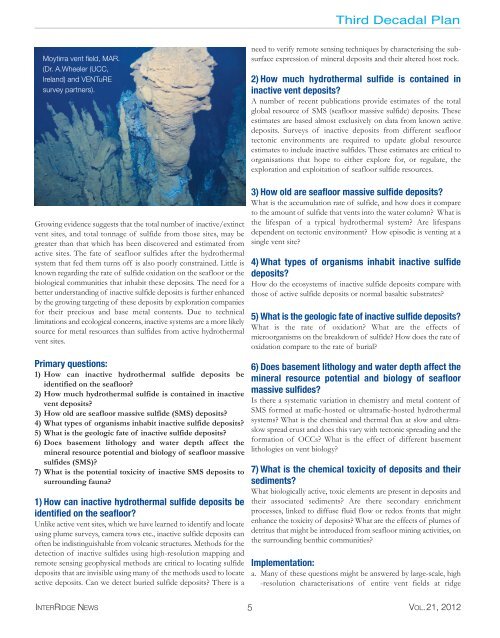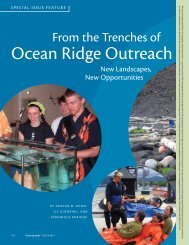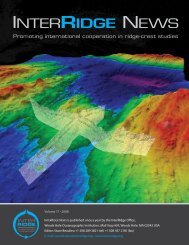Full version, low resolution, 7.5MB - InterRidge
Full version, low resolution, 7.5MB - InterRidge
Full version, low resolution, 7.5MB - InterRidge
Create successful ePaper yourself
Turn your PDF publications into a flip-book with our unique Google optimized e-Paper software.
Third Decadal Plan<br />
Moytirra vent field, MAR.<br />
(Dr. A.Wheeler (UCC,<br />
Ireland) and VENTuRE<br />
survey partners).<br />
need to verify remote sensing techniques by characterising the subsurface<br />
expression of mineral deposits and their altered host rock.<br />
2) How much hydrothermal sulfide is contained in<br />
inactive vent deposits?<br />
A number of recent publications provide estimates of the total<br />
global resource of SMS (seafloor massive sulfide) deposits. These<br />
estimates are based almost exclusively on data from known active<br />
deposits. Surveys of inactive deposits from different seafloor<br />
tectonic environments are required to update global resource<br />
estimates to include inactive sulfides. These estimates are critical to<br />
organisations that hope to either explore for, or regulate, the<br />
exploration and exploitation of seafloor sulfide resources.<br />
Growing evidence suggests that the total number of inactive/extinct<br />
vent sites, and total tonnage of sulfide from those sites, may be<br />
greater than that which has been discovered and estimated from<br />
active sites. The fate of seafloor sulfides after the hydrothermal<br />
system that fed them turns off is also poorly constrained. Little is<br />
known regarding the rate of sulfide oxidation on the seafloor or the<br />
biological communities that inhabit these deposits. The need for a<br />
better understanding of inactive sulfide deposits is further enhanced<br />
by the growing targeting of these deposits by exploration companies<br />
for their precious and base metal contents. Due to technical<br />
limitations and ecological concerns, inactive systems are a more likely<br />
source for metal resources than sulfides from active hydrothermal<br />
vent sites.<br />
Primary questions:<br />
1) How can inactive hydrothermal sulfide deposits be<br />
identified on the seafloor?<br />
2) How much hydrothermal sulfide is contained in inactive<br />
vent deposits?<br />
3) How old are seafloor massive sulfide (SMS) deposits?<br />
4) What types of organisms inhabit inactive sulfide deposits?<br />
5) What is the geologic fate of inactive sulfide deposits?<br />
6) Does basement lithology and water depth affect the<br />
mineral resource potential and biology of seafloor massive<br />
sulfides (SMS)?<br />
7) What is the potential toxicity of inactive SMS deposits to<br />
surrounding fauna?<br />
1) How can inactive hydrothermal sulfide deposits be<br />
identified on the seafloor?<br />
Unlike active vent sites, which we have learned to identify and locate<br />
using plume surveys, camera tows etc., inactive sulfide deposits can<br />
often be indistinguishable from volcanic structures. Methods for the<br />
detection of inactive sulfides using high-<strong>resolution</strong> mapping and<br />
remote sensing geophysical methods are critical to locating sulfide<br />
deposits that are invisible using many of the methods used to locate<br />
active deposits. Can we detect buried sulfide deposits? There is a<br />
3) How old are seafloor massive sulfide deposits?<br />
What is the accumulation rate of sulfide, and how does it compare<br />
to the amount of sulfide that vents into the water column? What is<br />
the lifespan of a typical hydrothermal system? Are lifespans<br />
dependent on tectonic environment? How episodic is venting at a<br />
single vent site?<br />
4) What types of organisms inhabit inactive sulfide<br />
deposits?<br />
How do the ecosystems of inactive sulfide deposits compare with<br />
those of active sulfide deposits or normal basaltic substrates?<br />
5) What is the geologic fate of inactive sulfide deposits?<br />
What is the rate of oxidation? What are the effects of<br />
microorganisms on the breakdown of sulfide? How does the rate of<br />
oxidation compare to the rate of burial?<br />
6) Does basement lithology and water depth affect the<br />
mineral resource potential and biology of seafloor<br />
massive sulfides?<br />
Is there a systematic variation in chemistry and metal content of<br />
SMS formed at mafic-hosted or ultramafic-hosted hydrothermal<br />
systems? What is the chemical and thermal flux at s<strong>low</strong> and ultras<strong>low</strong><br />
spread crust and does this vary with tectonic spreading and the<br />
formation of OCCs? What is the effect of different basement<br />
lithologies on vent biology?<br />
7) What is the chemical toxicity of deposits and their<br />
sediments?<br />
What biologically active, toxic elements are present in deposits and<br />
their associated sediments? Are there secondary enrichment<br />
processes, linked to diffuse fluid f<strong>low</strong> or redox fronts that might<br />
enhance the toxicity of deposits? What are the effects of plumes of<br />
detritus that might be introduced from seafloor mining activities, on<br />
the surrounding benthic communities?<br />
Implementation:<br />
a. Many of these questions might be answered by large-scale, high<br />
-<strong>resolution</strong> characterisations of entire vent fields at ridge<br />
INTERRIDGE NEWS 5 VOL.21, 2012
















